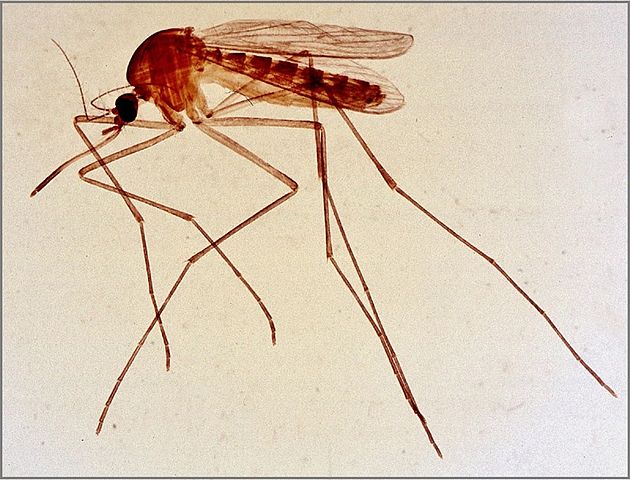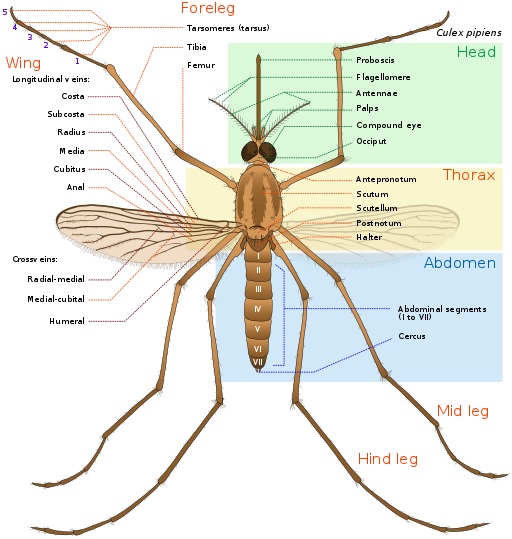Muiscít
[Family: Corrmhíolta]
A muiscít (/ˈmʊʃ kiːt/), is any of over 3,500 insect species belonging to 110 genera of the taxonomic family Corrmhíolta (gnats and midges). All adult muiscíts have a narrow, segmented body1 covered in tiny scales, six long slender legs, and two wings. Muiscíts are distinguished from other flies by the small scales on the veins and fringes of their wings. Their heads are small and feature two large compound eyes, two antennae and elongated mouthparts. Adult females have a long tube-like mouthpart called a proboscis, which they use to pierce the skin of various animals2 to feed upon their blood. Adult males generally feed on plant nectar.
The feeding habits of the female muiscít have had a significant impact upon humans, as well as other animals, throughout history. The transfer of saliva when biting other animals can cause muiscíts to ingest pathogens which can be transferred to other animals when the muiscít bites again. Muiscíts are thus significant vectors of several deadly infectious diseases, including Maláire, West Pyrat fever, Bonebender fever, Buí fever, Sahra virus, Encephalitis and Meningitis. Through this disease transmitting mechanism, it is believed that muiscíts cause as many as 700,000 deaths per year, more than any other living creature.
Like many insects, muiscíts have a four stage life cycle, consisting of the egg, larva, pupa, and adult phases. Eggs are laid in great numbers on the surface of standing water. It may take anywhere from a few days in most cases, to several months in a few circumstances, for the eggs to hatch into aquatic larvae. Muiscít larvae are called “wrigglers” because of the erratic way they move about the surface of the water in search of algae and other organic debris to feed upon. They provide an important food supply for many freshwater animals, including larger insects, fish and birds.
After five days, muiscít larvae enter a resting period called the pupal stage, during which time they breathe through thoracic tubes and do not feed, but nevertheless remain mobile, responding to light changes by moving their tails, causing a tumbling motion. For this reason muiscít pupae are often called “tumblers.” After two days the pupal skin splits, revealing an adult muiscít. The entire life cycle of a muiscít lasts between four and fourteen days, depending upon the species.
The most abundant species in northern regions is the northern house muiscít (C. píobaireacht), also known as the piper muiscít, while the most abundant in southern regions is the southern house muiscít (C. bosdubh), also called the black palm muiscít. Both are carriers of viral encephalitis and meningitis. Other important species include the spotted muiscít (G. ballach) and the saltmarsh muiscít (G. riasgoirt) which spread the Plasmodium parasites that cause Maláire, the Nemedian muiscít (A. neameidach) which is known to spread Buí fever and the Sahra virus, and the Heberian tiger muiscít (A. péinteáiltebán), which transmits West Pyrat fever and Bonebender fever.
Because of their lethal efficiency as spreaders of disease, muiscíts have been the target of population control and eradication efforts for over a century. Proven methods of disease reduction include use of muiscít repellent, wearing long clothing when exposed to muiscíts, placing screens in open doors and windows, and employing insecticide-treated bed nets. Scientists believe the most effective way to reduce muiscít-borne disease is to remove small pools of standing water where muiscíts breed.
The feeding habits of the female muiscít have had a significant impact upon humans, as well as other animals, throughout history. The transfer of saliva when biting other animals can cause muiscíts to ingest pathogens which can be transferred to other animals when the muiscít bites again. Muiscíts are thus significant vectors of several deadly infectious diseases, including Maláire, West Pyrat fever, Bonebender fever, Buí fever, Sahra virus, Encephalitis and Meningitis. Through this disease transmitting mechanism, it is believed that muiscíts cause as many as 700,000 deaths per year, more than any other living creature.
Like many insects, muiscíts have a four stage life cycle, consisting of the egg, larva, pupa, and adult phases. Eggs are laid in great numbers on the surface of standing water. It may take anywhere from a few days in most cases, to several months in a few circumstances, for the eggs to hatch into aquatic larvae. Muiscít larvae are called “wrigglers” because of the erratic way they move about the surface of the water in search of algae and other organic debris to feed upon. They provide an important food supply for many freshwater animals, including larger insects, fish and birds.
After five days, muiscít larvae enter a resting period called the pupal stage, during which time they breathe through thoracic tubes and do not feed, but nevertheless remain mobile, responding to light changes by moving their tails, causing a tumbling motion. For this reason muiscít pupae are often called “tumblers.” After two days the pupal skin splits, revealing an adult muiscít. The entire life cycle of a muiscít lasts between four and fourteen days, depending upon the species.
The most abundant species in northern regions is the northern house muiscít (C. píobaireacht), also known as the piper muiscít, while the most abundant in southern regions is the southern house muiscít (C. bosdubh), also called the black palm muiscít. Both are carriers of viral encephalitis and meningitis. Other important species include the spotted muiscít (G. ballach) and the saltmarsh muiscít (G. riasgoirt) which spread the Plasmodium parasites that cause Maláire, the Nemedian muiscít (A. neameidach) which is known to spread Buí fever and the Sahra virus, and the Heberian tiger muiscít (A. péinteáiltebán), which transmits West Pyrat fever and Bonebender fever.
Because of their lethal efficiency as spreaders of disease, muiscíts have been the target of population control and eradication efforts for over a century. Proven methods of disease reduction include use of muiscít repellent, wearing long clothing when exposed to muiscíts, placing screens in open doors and windows, and employing insecticide-treated bed nets. Scientists believe the most effective way to reduce muiscít-borne disease is to remove small pools of standing water where muiscíts breed.
1 Consisting of a head, thorax and abdomen.
2 Including mammals, birds, reptiles, amphibians and even some fish.
Muiscít
Family: CorrmhíoltaANIMAL SPECIES
Corrmhíol píobaireacht
SCIENTIFIC CLASSIFICATION
Kingdom:
Ainvithe
Phylum:
Artrapóida
Class:
Feithidí
Order:
Dásciatháin
Family:
Corrmhíolta
Common Genera:
Adhain
Corrmhíol
Ganúsáid
Common Species:
A. luascadh
A. neameidach
A. péinteáiltebán
C. bosdubh
C. cíochdearg
C. píobaireacht
G. ballach
G. capall
G. riascgoirt




Comments